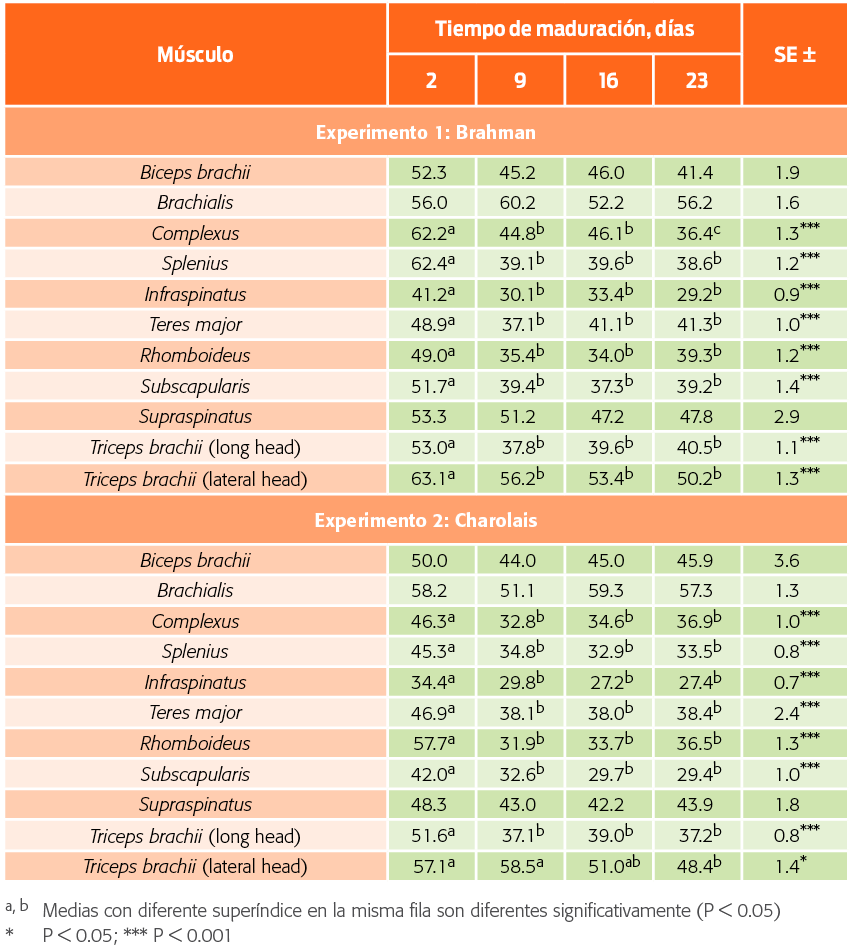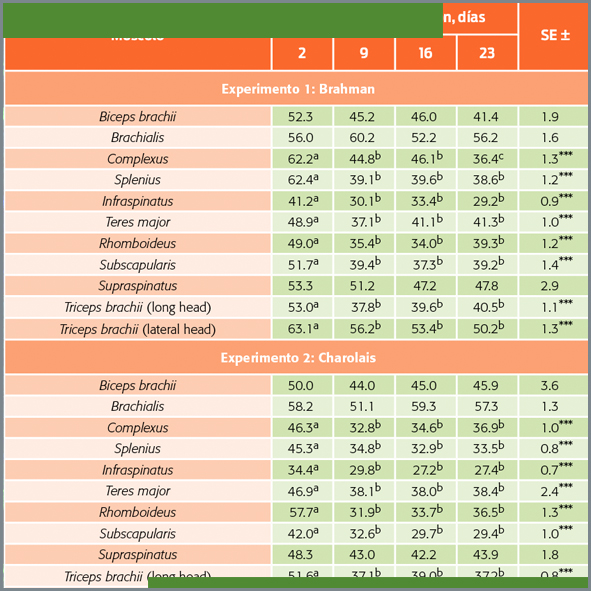La estrategia de congelación, descongelación y maduración mejora la suavidad de los músculos del cuarto delantero de toretes sin castrar de diferentes fenotipos
Contenido principal del artículo
Resumen
Veterinaria México OA
ISSN: 2448-6760
Cómo citar este artículo:
- Rubio-Lozano MS, Pérez-Buitrón EV, Méndez-Medina RD, Chávez-Gómez A, Delgado-Suárez EJ. La estrategia de congelación, descongelación y maduración mejora la suavidad de los músculos del cuarto delantero de toretes sin castrar de diferentes fenotipos. Veterinaria México OA. 2014;1(1). doi: 10.21753/vmoa.1.1.333.
Se evaluó el efecto de la congelación seguida de la descongelación y maduración por 2, 9, 16 y 23 días en la fuerza de corte Warner-Bratzler (FC) en 11 músculos del cuarto delantero de toretes sin castrar de origen Brahman (BR, n = 10) y Charolais (CH, n = 10) seleccionados fenotípicamente. Splenius, infraspinatus, teres major, rhomboideus, y subscapularis de ambos fenotipos, y complexus de CH tuvieron valores típicos de carne suave (FC ≤ 40 N) a los 9 días de maduración. La FC no mejoró después de los 9 días de maduración. En general, se observó que la congelación con una posterior descongelación y maduración de varios de los músculos estudiados mejoró significativamente la suavidad de la carne. Se requiere realizar otros estudios para optimizar esta estrategia de ablandamiento, así como para evaluar su posible impacto en otros atributos de la calidad de la carne.
Cuadro 1. Medias de mínimos cuadrados de la fuerza de corte (N) para los músculos del cuarto delantero en toretes de Brahman y Charolais, congelados por una semana, descongelados por 24-30 horas a 2-4°C y madurados durante diferentes periodos

Detalles del artículo
Citas
AMSA. 1995. Research guidelines for cookery, sensory evaluation, and instrumental tenderness measurements of fresh meat. In: Chicago, IL: American Meat Science Association and National Livestock and Meat Board.
Belew, J.B., Brooks, J.C., McKenna, D.R., and Savell, J.W. 2003. Warner–Bratzler shear evaluations of 40 bovine muscles. Meat Science. 64(4): 507-512.
Bidner, T.D., Wyatt, W.E., Humes, P.E., Franke, D.E. and Blouin, D.C. 2002. Influence of Brahman-derivative breeds and Angus on carcass traits, physical composition, and palatability. Journal of Animal Science. 80: 2126-2133.
Bonilha, S.F.M., Tedeschi, L.O., Packer, I.U., Razook, A.G., Alleoni, G.F., Nardon, R.F. and Resende, F.D. 2008. Evaluation of carcass characteristics of Bos indicus and tropically adapted Bos taurus breeds selected for postweaning weight. Journal of Animal Science. 86(8): 1770-1780.
Bratcher, C.L., Johnson, D.D., Littell, R.C. and Gwartney, B.L. 2005. The effects of quality grade, aging, and location within muscle on Warner–Bratzler shear force in beef muscles of locomotion. Meat Science. 70(2): 279-284.
Camponova. 2006. Suministran anabólicos al 70 por ciento del ganado en México. 2000Agro Revista Industrial del Campo. Nov 9. Sección Agroindustria. http://www.2000agro.com.mx/agroindustria/suministran-anabolicos-a-70-por-ciento-del-ganado-en-mexico/.
Claus, H.L., Dikeman, M.E., Murray, L., Brooks, J.C., Shook, J., Hilton, G.G., Lawrence, T.E., Mehaffey, J.M., Johnson, B.J., Allen, D.M., Streeter, M.N., Nichols, W.T., Hutcheson, J.P., Yates, D.A., Miller, M.F., Hunt, M.C. and Killefer, J. 2010. Effects of supplementing feedlot steers and heifers with zilpaterol hydrochloride on Warner–Bratzler shear force interrelationships of steer and heifer longissimus lumborum and heifer triceps brachii and gluteus medius muscles aged for 7, 14 and 21d. Meat Science 85(2): 347-355.
Crouse, J.D. and Koohmaraie, M. 1990. Effect of freezing of beef on subsequent postmortem aging and shear force. Journal of Food Science. 55(2): 573-574.
Chávez, A., Pérez, E., Rubio, M.S., Méndez, R.D., Delgado, E.J. and Díaz, D. 2012. Chemical composition and cooking properties of beef forequarter muscles of Mexican cattle from different genotypes. Meat Science. 91(2): 160-164.
Grayson, A.L., King, D.A., Shackelford, S.D., Koohmaraie, M. and Wheeler, T.L. 2014. Freezing and thawing or freezing, thawing, and aging effects on beef tenderness. Journal of Animal Science. 92: 2735-2740.
Gruber, S.L., Tatum, J.D., Scanga, J.A., Chapman, P.L., Smith, G.C. and Belk, K.E. 2006. Effects of postmortem aging and USDA quality grade on Warner-Bratzler shear force values of seventeen individual beef muscles. Journal of Animal Science. 84(12): 3387-3396.
Hildrum, K.I., Rodbotten, R., Hoy, M., Berg, J., Narum, B. and Wold, J.P. 2009. Classification of different bovine muscles according to sensory characteristics and Warner Bratzler shear force. Meat Science. 83(2): 302-307.
King, D.A., Wheeler, T.L., Shackelford, S.D. and Koohmaraie, M. 2009. Comparison of palatability characteristics of beef gluteus medius and triceps brachii muscles. Journal of Animal Science. 87(1): 275-284.
Koohmaraie, M. 1990. Quantification of Ca2(+)-dependent protease activities by hydrophobic and ion-exchange chromatography. Journal of Animal Science. 68: 659-665.
Li, K., Zhang, Y., Mao, Y., Cornforth, D., Dong, P., Wang, R., Zhu, H. and Luo, X. 2012. Effect of very fast chilling and aging time on ultra-structure and meat quality characteristics of chinese yellow cattle M. Longissimus lumborum. Meat Sci. 92(4),: 795-804.
Mach, N., Bach, A., Realini, C.E., Font i Furnols, M., Velarde, A. and Devant, M. 2009. Burdizzo pre-pubertal castration effects on performance, behaviour, carcass characteristics, and meat quality of holstein bulls fed high-concentrate diets. Meat Science. 81(2): 329-334.
Mendez, R.D., Meza, C.O., Berruecos, J.M., Garces, P., Delgado, E.J. and Rubio, M.S. 2009. A survey of beef carcass quality and quantity attributes in Mexico. Journal of Animal Science. 87(11): 3782-3790.
Molina, M.E., Johnson, D.D., West, R.L. and Gwartney, B.L. 2005. Enhancing palatability traits in beef chuck muscles. Meat Science. 71(1): 52-61.
Nelson, J.L., Dolezal, H.G., Ray, F.K. and Morgan, J.B. 2004. Characterization of certified Angus beef steaks from the round, loin, and chuck. Journal of Animal Science. 82: 1437-1444.
Rhee, M. S., Wheeler, T.L., Shackelford, S.D. and Koohmaraie, M. 2004. Variation in palatability and biochemical traits within and among eleven beef muscles. Journal of Animal Science. 82: 534-550.
Rubio L.M.S., Méndez M.R.D. and Huerta-Leidenz, N. 2007. Characterization of beef semimembranosus and adductor muscles from US and Mexican origin. Meat Science. 76(3): 438-443.
Searls, G.A., Maddock, R.J. and Wulf, D.M. 2005. Intramuscular tenderness variation within four muscles of the beef chuck. Journal of Animal Science. 83: 2835-2842.
Shackelford, S.D., Wheeler, T.L. and Koohmaraie, M. 1995. Relationship between shear force and trained sensory panel tenderness ratings of 10 major muscles from Bos indicus and Bos taurus cattle. Journal of Animal Science. 73: 3333-3340.
Simões, J.A., Mendes, M.I. and Lemos, J.P.C. 2005. Selection of muscles as indicators of tenderness after seven days of ageing. Meat Science. 69(4): 617-620.
Stelzleni, A.M., Patten, L.E., Johnson, D.D., Calkins, C.R. and Gwartney, B.L. 2007. Benchmarking carcass characteristics and muscles from commercially identified beef and dairy cull cow carcasses for Warner-Bratzler shear force and sensory attributes. Journal of Animal Science. 85(10): 2631-2638.
Vieira, C., Diaz, M.T., Martinez, B. and Garcia-Cachan, M.D. 2009. Effect of frozen storage conditions (temperature and length of storage) on microbiological and sensory quality of rustic crossbred beef at different states of ageing. Meat Sci. 83(3): 398-404.
Von Seggern, D.D., Calkins, C.R., Johnson, D.D., Brickler, J.E. and Gwartney, B.L. 2005. Muscle profiling: Characterizing the muscles of the beef chuck and round. Meat Science. 71(1): 39-51.
Yadata, M.A., Werner, C., Tibbo, M., Wollny, C.B.A. and Wicke, M. 2009. Assessment of the sensory quality and shelf stability of selected Horro beef muscles in Ethiopia. Meat Science. 83(1): 113-119
License

Veterinaria México OA por Facultad de Medicina Veterinaria y Zootecnia de la Universidad Nacional Autónoma de México se distribuye bajo una Licencia Creative Commons Atribución 4.0 Internacional.
Basada en una obra en http://www.revistas.unam.mx
- Todos los artículos en Veterinaria México OA se publican bajo una licencia de Creative Commons Reconocimiento 4.0 Unported (CC-BY 4.0). Con esta licencia, los autores retienen el derecho de autor, pero permiten a cualquier usuario compartir, copiar, distribuir, transmitir, adaptar y hacer uso comercial de la obra sin necesidad de proporcionar un permiso adicional, siempre y cuando se otorgue el debido reconocimiento al autor o fuente original.
- Al utilizar esta licencia, los artículos en Veterinaria México OA cubren o exceden todos los requisitos fundacionales e institucionales para ser considerados de Acceso Abierto.
- Los autores no pueden utilizar material protegido por derechos de autor en su artículo a menos que ese material esté también disponible bajo una licencia igualmente generosa.



